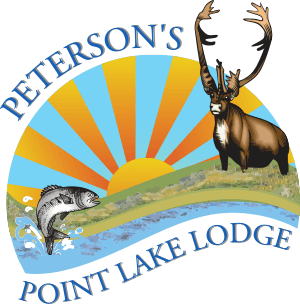Category: Uncategorized
Autumn in the Barrenlands – A Hikers & Photographers Arctic Oasis
The Barrenlands. It may sound lonesome, and over the winter there is some truth to that sentiment as the vast expanse of snow looks deserted. However, in the summer life erupts as the daylight grows and the warmth of the sun returns as do many animals and birds. The landscape transforms into a blanket of green and blooming flowers.
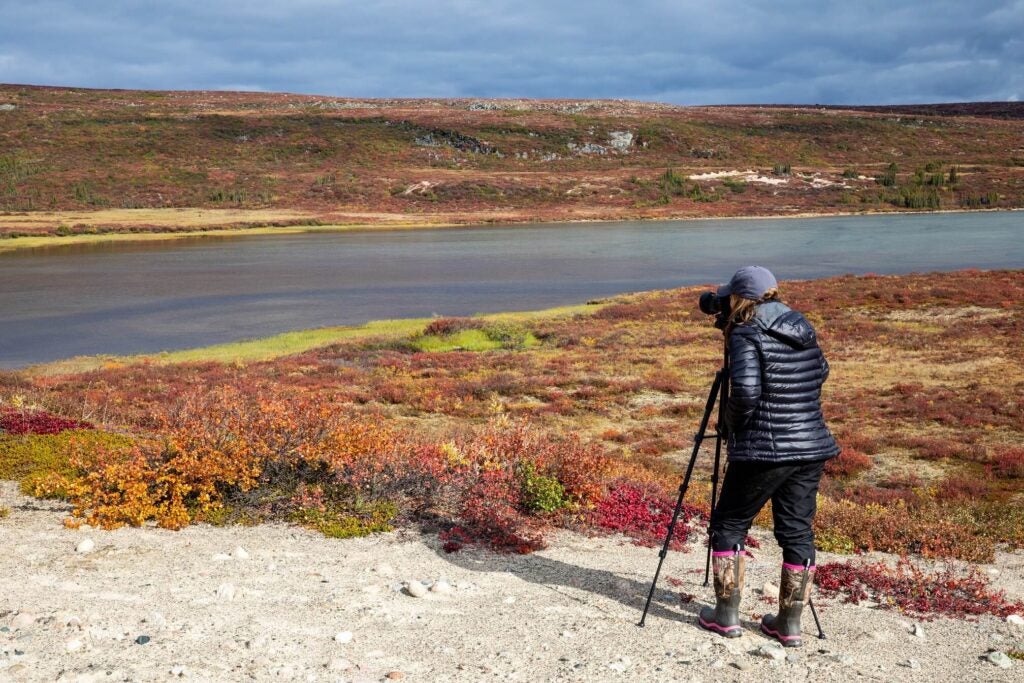
Although the summers are brief, the daylight hours are long, and the flora and fauna that live here, even temporarily, take full advantage of the conditions. Every aspect of growth is expedited in the barrens, one could almost say the plants race to fulfill the innate purpose to germinate, propagate, and spread their seeds to prepare before the end of the arctic summer.
The same goes for the animals, to have and rear their young before the night returns and temperatures drop; life stages, birth, maturity and hibernation or death happens so much faster than their southern cousins.
As the Arctic summer wanes, the ground cover bursts into a deep crimson, specked with yellows, golds and oranges. It makes for incredible landscape photography and it’s the perfect time of year to capture wildlife with the fall drapery as a backdrop. The different shades of blue from the sky and lake also provide an incredible canvas of natural colours that contrast rich colours of fall.
Escape to the Barrenlands
Getting here takes some effort – it’s off the beaten path. However, there is a remote lodge, Peterson’s Point Lake Lodge, that provides access, comfortable accommodation, transportation, expert guides and warm hospitality for those seeking the unique riches of the barrenlands. Spectacular fishing, incredible hiking and tremendous photography opportunities are some of the experiences that are relished here.
Imagine flying 200 miles north of Yellowknife on a float plane, while watching the treeline disappear and seeing a wilderness lodge situated on the shore of a mile long sand beach; it’s a haven in the middle of these glacial swept lands that stretch as far as the eye can see, with undulating hills and steep cliffs.
Birds come to have their young and wildlife like the iconic caribou migrate through the area. Trophy lake trout lurk in the waters below, waiting to be caught and starlit skies are the backdrop to the northern lights. With access to incredible outdoor experiences (fishing, hiking, northern lights viewing, nature, wildlife and photo opportunities) right outside your cabin door it’s no wonder that people looking for an authentic northern experience are drawn to come here.
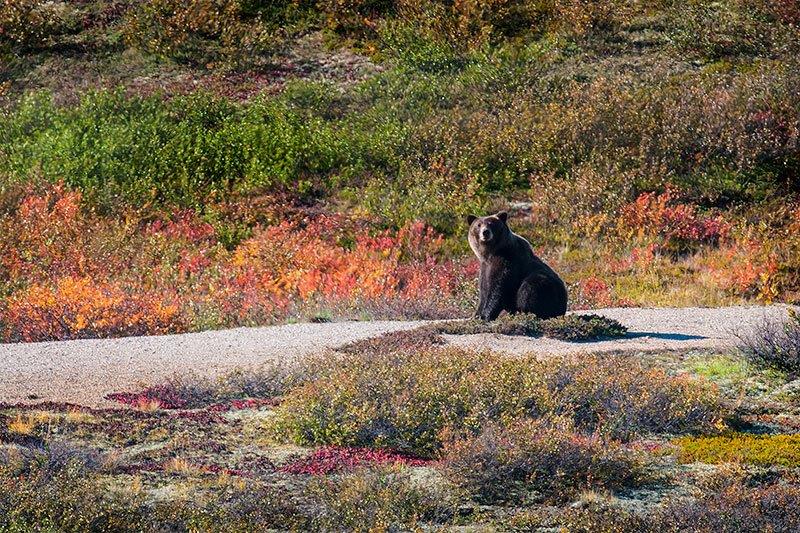
Located in a land beyond the trees where there is no manmade groomed trail system there are limitless hiking opportunities. The time-honoured traditional caribou routes have carved out trails that provide good hiking as do the sand eskers and rolling landscape.
Endless Adventures In The Arctic. There are great hikes starting right from the lodge while other ‘trail heads’ if you will, require a boat ride. A number of the hikes have been picked out for their stunning surroundings and interesting geological features, such as an aufeis. They also provide incredible viewpoints to watch for wildlife. The hikes range in length and guides will accompany you for their wildlife spotting skills, safety and sharing their personal first-hand knowledge of the area.
This is grizzly bear country, and guides are on the lookout for bears in addition to other commonly sighted larger animals, such as the caribou, moose, wolf, wolverine, smaller animals such as sik siks and weasels. There are a variety of birds, from raptors like the peregrine falcon and eagle to waterfowl, songbirds, seabirds and grouse.
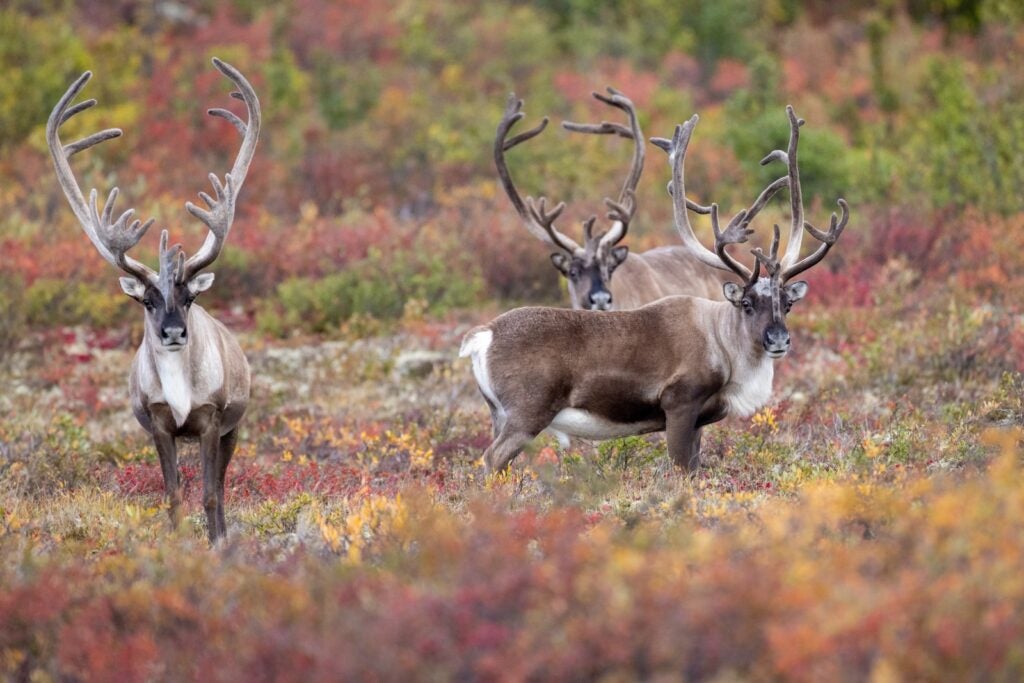
The guides carry a firearm with them as part of their equipment, it’s a normal part of the routine just as are lifejackets. Guests are reminded to keep watch and look up with regularity if they stop to pick from any of the numerous berry patches that naturally grow here (blueberries, crowberries, cloudberries and, the locally sought after cranberry).
Each type of berry typically ripens at different times, some overlapping. The picking season often starts in August so they can be enjoyed throughout the autumn. The lodge will happily supply you with a container so you can pick berries as you trek over the barrens to enjoy as a snack along the way, bring them back to the cook where she’ll prepare something delicious for you or take them home with you.
While hiking there are innumerable ground level (macro) photo opportunities. Look closely and you will see minute flowers, dwarf shrubs, mushrooms, colorful lichens and mosses all jumbled together into a mosaic of intricate beauty. Upon closer look you may even find a bird’s nest, animal scat, providing clues to their proximity, including evidence of their last meal, in addition to pieces of history, ancient and hidden artifacts from peoples and explorers that travelled through this area long ago.
The terrain changes throughout the 70 miles over which Point Lake spans providing you a new experience each day. This large waterway is part of the legendary Coppermine River System, it provides access to explore the surrounding area while looking for wildlife.
Guests can enjoy a diverse menu of activities during Peterson’s Point Lake Lodges’ Explorer’s Package and there’s no need not worry about keeping pace with everyone in the group while on hikes. Participants will naturally group based on energy levels, pace, and interests. Lunch breaks and end of the day rendezvous points/times are designated and often participants may have the opportunity to meet before returning to the lodge.
Several of Peterson’s Point Lake Lodge trips have expert guides that accompany the regular guide team who share their knowledge and offer professional tips. Whether you are interested in improving your photography skills while focusing on wildlife photography, landscape photography and/or northern lights photography (such as in their Arctic Photography Workshop and Aurora Experience) or learning about the unique flora and fauna as offered in the Barrenland Naturalist Tour, the guide team is happy to share.
Capture The Aurora In The Heart Of The Barrens
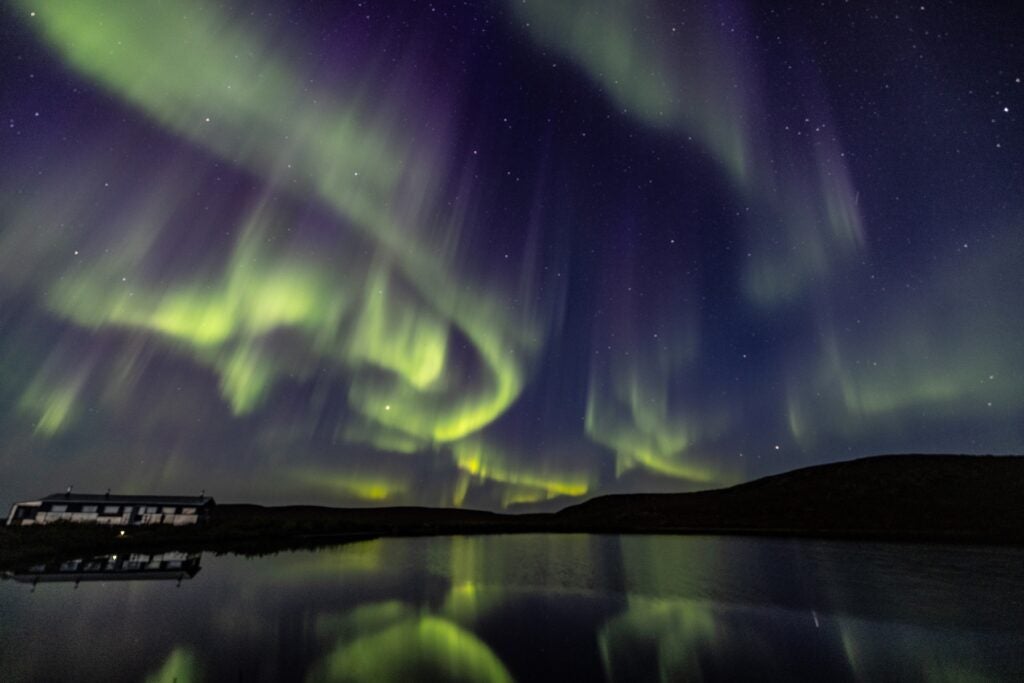
At night, the photographer’s adventure doesn’t end. The Barren Lands are an ideal spot to witness the Northern Lights, also known as Aurora Borealis. Light pollution doesn’t exist in these parts. Beneath the sprawling sky that has no beginning or no end you can learn the perfect way to photograph this natural phenomenon.
Experiencing fall on the Northwest Territories tundra with Peterson’s Point Lake Lodge will leave you wanting more. The possibilities of what you may find are endless – you may have up close and personal encounters, where you will be treated to moments that typically are only witnessed in nature documentaries.
Equally as rewarding is spending time with people that share similar interests and the profound feeling you can only get from time spent in the barrens, it’s barely palpable and hardly describable, for some it’s a calling that will lure you back again. Join Peterson’s Point Lodge’s this year and become immersed in the barrens. Book your Arctic adventure with Peterson’s Point Lake Lodge today.
Top 10 Tips –
Macro photography is all about showcasing a subject larger than it is in real life — an extreme close-up of something small. There are dedicated Macro lenses and extension tubes to use with your existing lenses, both will help you get closer and “enlarge” the flower, bug, berry, or whatever subject of your choosing, so you can compose a full frame image of “something small”. A dedicated Macro lens has advantages over the extension tubes – they also cost more. Do some reading and decide what is best for you. If you are using a point and shoot camera, you don’t have to worry about either, but you will need to check your camera for a “close-up” mode or see how close you can zoom in to something and still focus. One of the key parts of creating a macro image is to slow down, think about what you want to capture, then set about doing it.
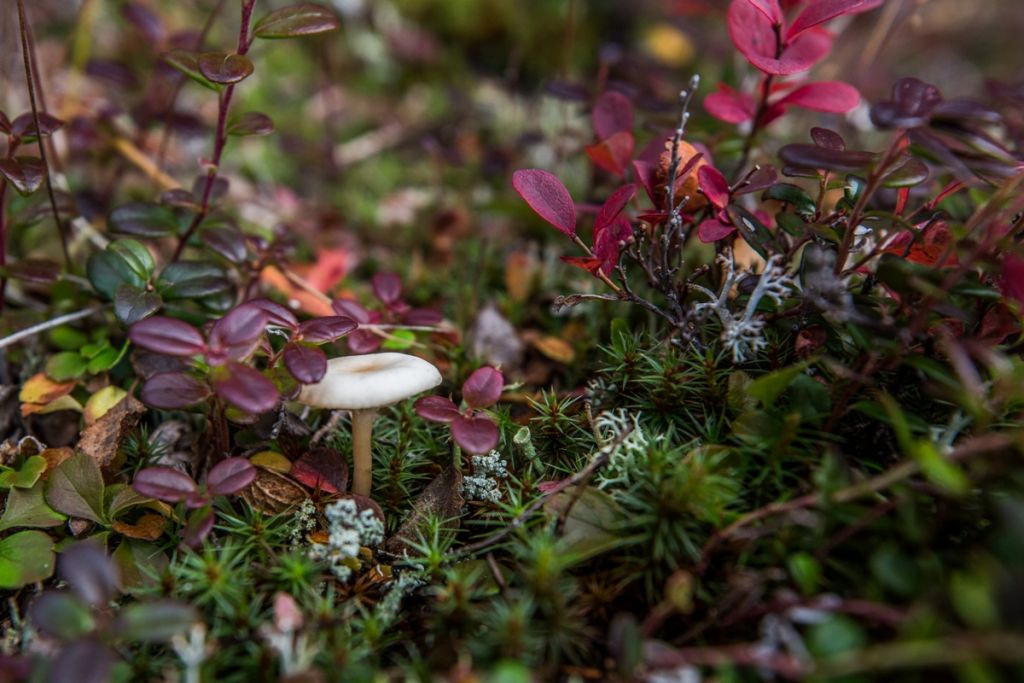
Here are some of my top 10 tips for shooting macro while on the tundra.
- Adjust the focus. Use manual focus or adjust your focal point to focus directly where you want it. Ending up with a sharp image depends on other factors in your exposure, but if none of it will work out if you haven’t focused to begin with. Determine where you want the “sharpest” place to be in the final image, and make sure you are tack sharp there before you shoot. Practice focusing on the front, middle & back of your subject, and see what the results look like.
- Stabilize your camera. If possible, use a tripod, if not, try a bean bag, or rest your camera on something. If you can’t do any of those things, be sure to have your shutter speed high enough to stop any movement. Not just your camera movement, but also the subject, bugs move, flowers blow in the wind. You need to be sure you have enough light to balance your shutter speed with the f-stop you want. Practice holding your camera at slower shutter speeds and see what a realistic slow limit for you is, then stay above it.
- Be Creative. If your subject is movable, move it, and set up the shot you want. Sometimes you can change the foreground, background, lighting conditions and so on. If you are comfortable moving that bug to a pretty branch or leaf, do it. If you are shooting a mushroom, or berry that you can’t move, you will need to move yourself and your camera. Try different angles, directions, use a coat or diffuser to reduce hot spots, or reflector or hunk of white cardboard to lighten shadows.
- Experiment. After you have the shot composed the way you want it, shoot a bunch of images. Change your f-stop, change your focal point, and experiment. Use your creative brain to change the way the scene looks, or how your subject is captured within your initial composition.
- Play with bokeh. Simply put, bokeh is the pleasing or aesthetic quality of out-of-focus blur in a photograph. You can create that blur or soft focus by adjusting your f-stop, or changing your focal point.
- Keep it tidy. When you are shooting a close-up, everything shows up. Dirt, stray leaves or twigs, grass in the foreground, damage to the edge of a mushroom, blemishes on berries, and so many things you never see if you aren’t looking. “Landscape” if you can but be careful not to disturb your subject. Look at your berry or mushroom closely before you set up your shot, pick its good side, or maybe its “sister” is in better shape. Look around and pick your subject, and your composition based on the scene you want to capture.
- Use different angles. Try to start with your lens parallel to the subject, that will increase you focus area, but experiment as you go. Shoot top down, bottom up, change the image based on what angle you see it from.
- Shoot sample shots & adjust as you go. Sometimes you will see distracting light spots, or stray grass, look for leading lines, check your focus, see if you should be closer, or if you are too close… refer to rule number one, Shoot a lot… slow down and have fun!
By Cheryl Stewart
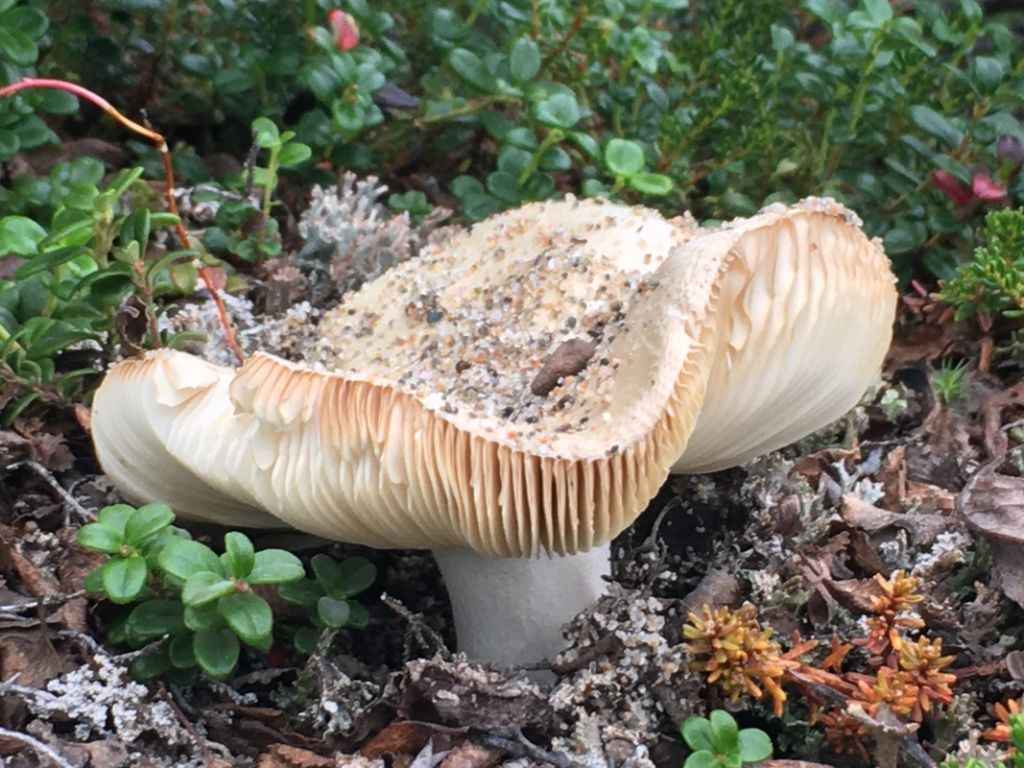
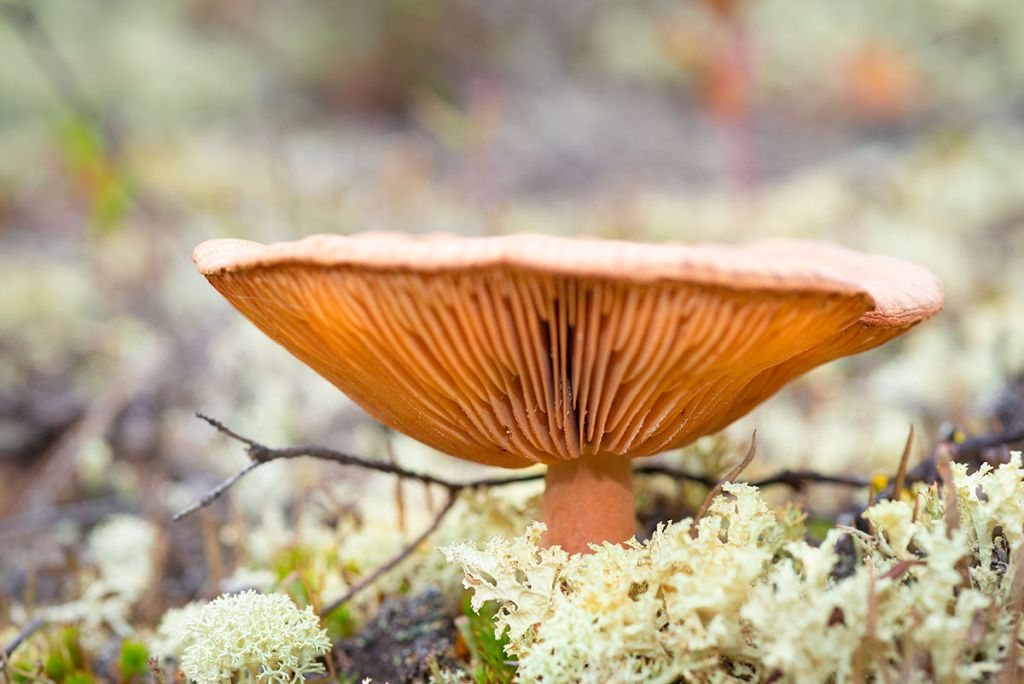
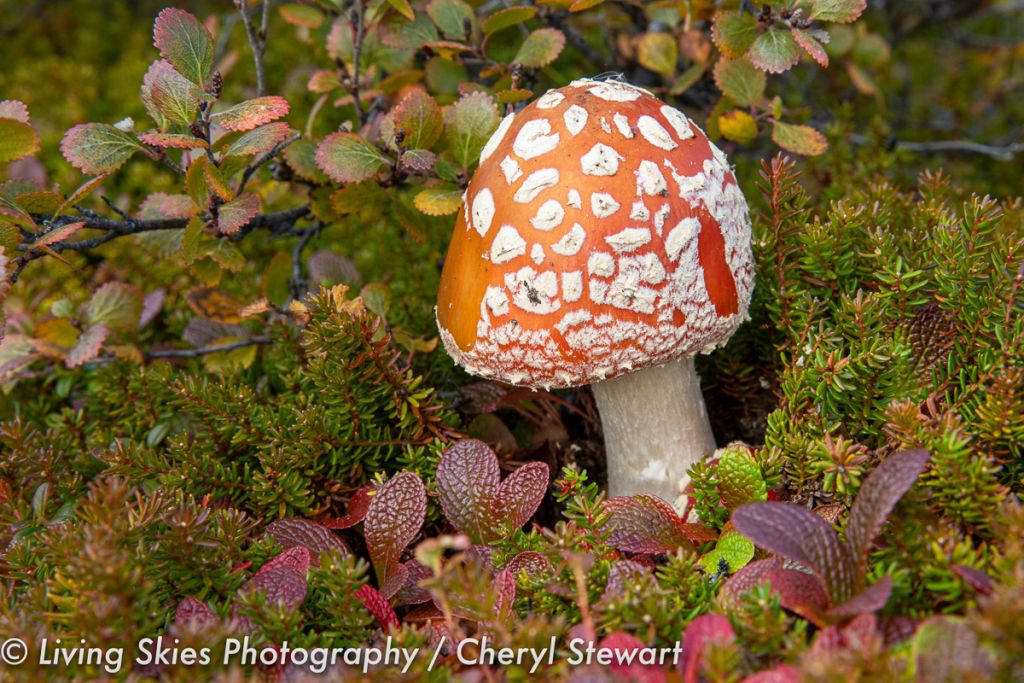
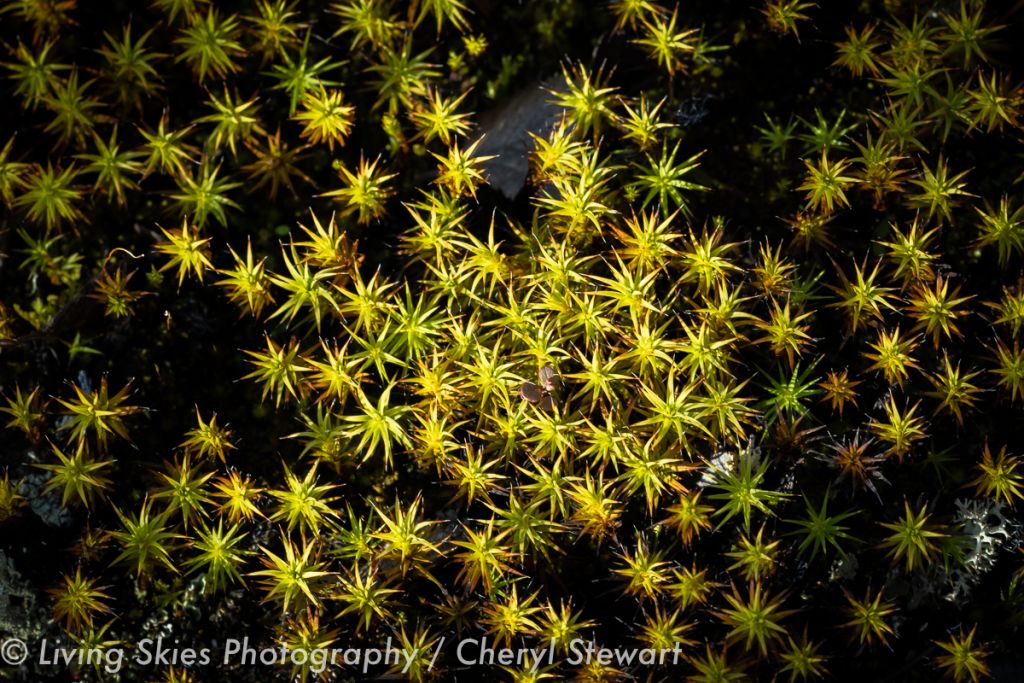
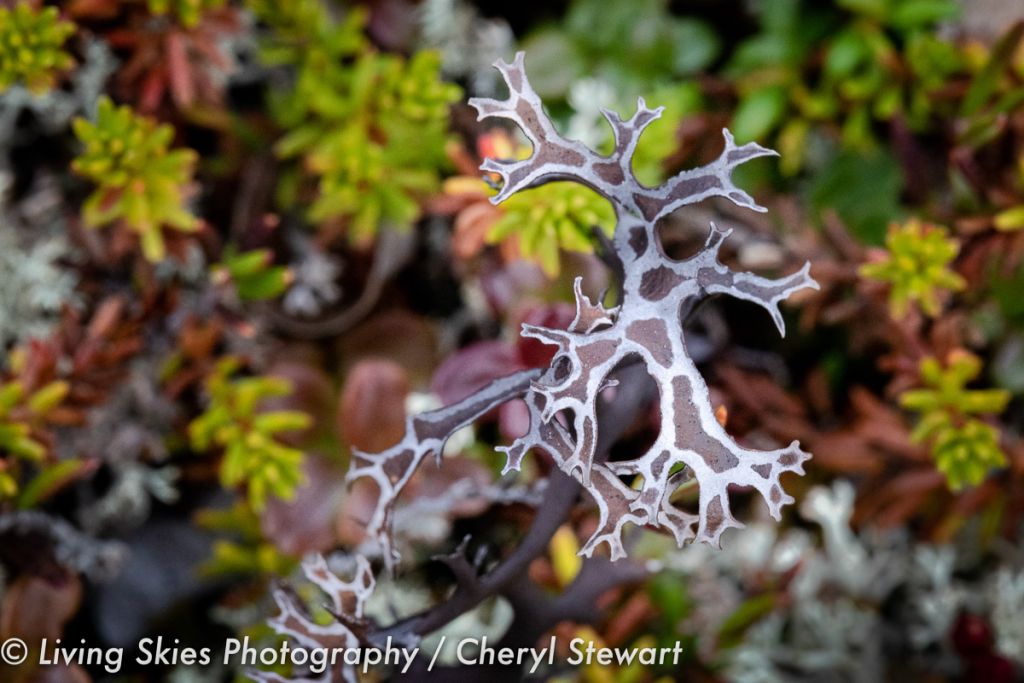
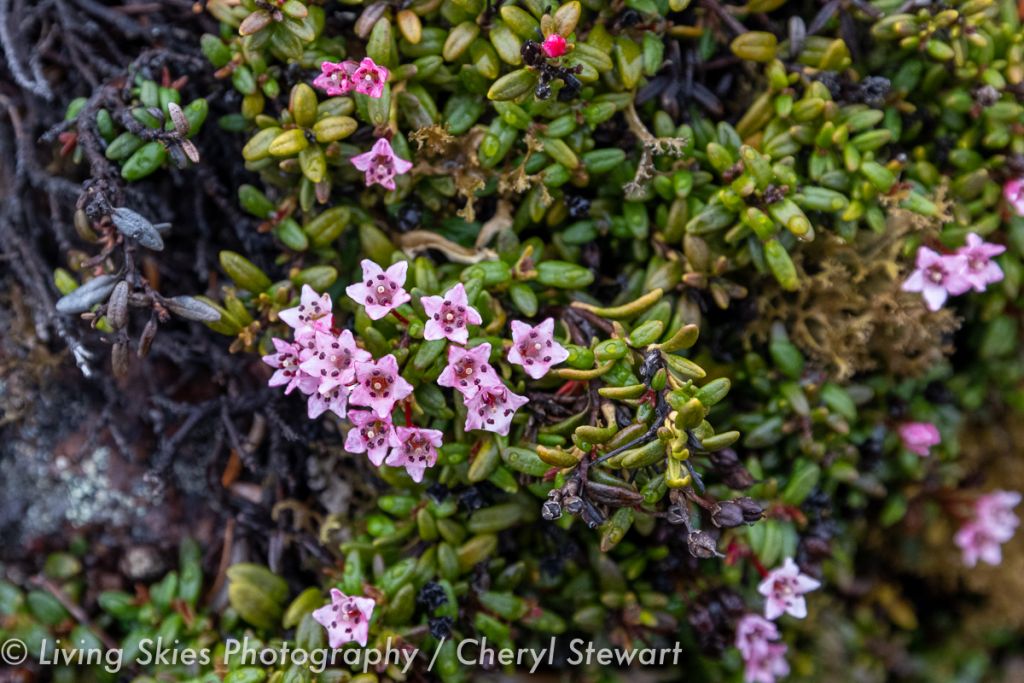
Lake Trout Fishing and Arctic Grayling Fishing
Whether you prefer lots of action and aim to catch smaller lake trout or want to break the 58lb record, Peterson’s Point Lake Lodge offers both experiences. Throughout the summer, Point Lake offers lake trout fishing enthusiasts the opportunity to catch trophy fish in shallow water. Getting a strike from a lake trout at a depth range of 20-25′ makes for a exciting catch and a lot of action; they’re known for their aggressive hard fighting spirit.
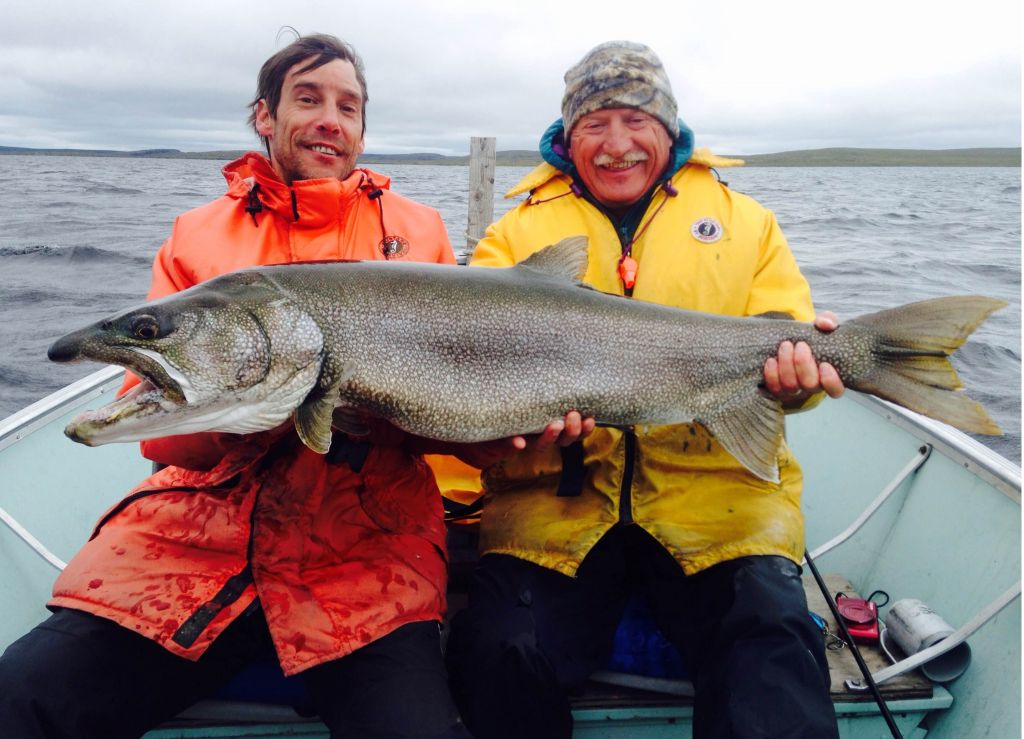
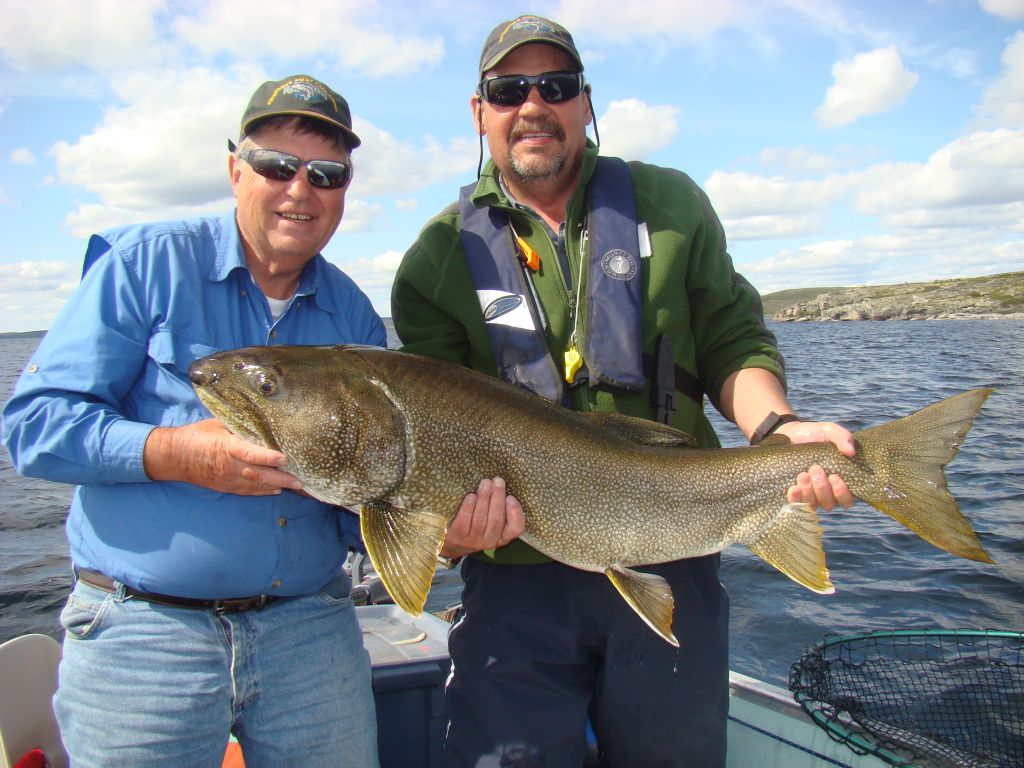
Lake Trout
Likely you are already familiar with some facts about lake trout but for good measure we’re including some details about the species, in addition to nutritional information for your general and culinary interests
Lake Trout, Salvelinus namaycush, means ‘an old name for char’ ‘tyrant of the lake’.
They are a member of the salmon family, inhabiting large lakes and are silver, green or dark purple in colour. Their flesh can be orange or white in colour pending on diet. The smaller lake trout have orange-red flesh, this is a result of a concentration of flies, insects and crustaceans in their diet. On the other hand, larger trout commonly have white coloured flesh due to consuming other fish. They pursue and devour large prey, including other trout, as well as species like grayling, whitefish and ciscoe’s. No lure is too big or too fast for these ferocious carnivores. Trout in the far north do not begin spawning until 7-13 years of age. Typically, they spawn in the fall every second or third year. They are the only member of the Salmon family that spends its’ entire life cycle in lakes.
Preferred temperature is 50-60ºF
Learn more about our amazing fishing trips: 7-Day Fishing Trip, 5-Day Fishing Trip, 4-Day Fishing Trip and other multi-day adventures where fishing is included.
Arctic Grayling
Arctic grayling, Thymallus arcticus, are found throughout most of the mainland in the Northwest Territories. They generally inhabit only those lakes and rivers with clear cold water. In large lakes they stay close to rocky shores and near the mouths of streams. Their most distinctive feature is a large and colourful dorsal fin. The back is dark purple or bluish-black, shading to silver on the sides (speckled with a few black spots) and white below
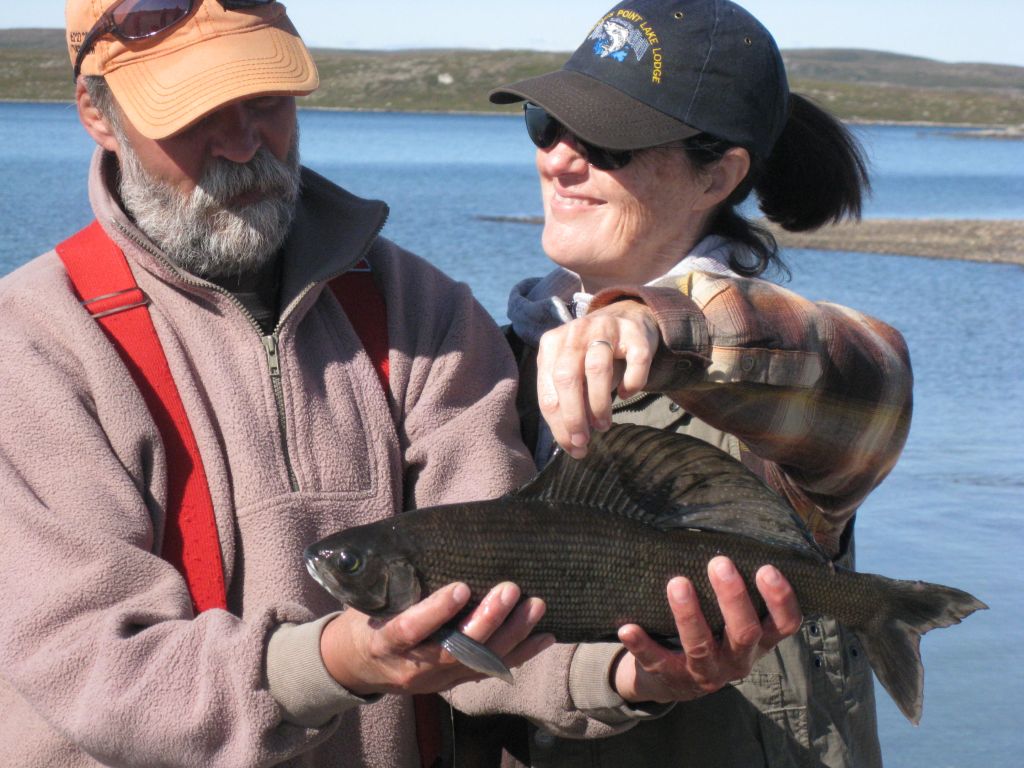
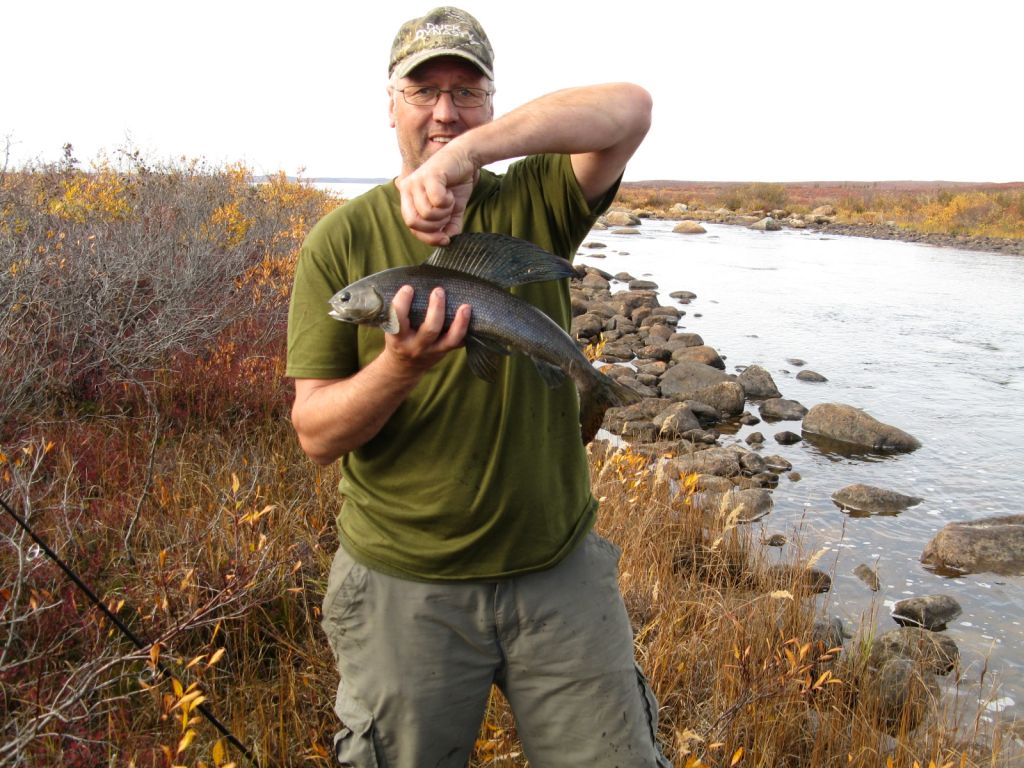
There are opportunities to fish for Arctic Grayling at one of the tributaries that flow into Point Lake or in the small lake behind your cabin.
Arctic grayling can reach sizes more than 20” (30-40 cm), and can weigh up to 5 lbs.
Their diet is comprised of insects, as a result offer some of the best sport fly fishing. They are energetic fighters, putting up a good battle for their size. Their tendency to leap out of the water when caught, their readiness to take hook, their soft mouth, their beauty and good taste, all make the grayling a very popular sport fish.
Learn more about our amazing fishing trips: 7-Day Fishing Trip, 5-Day Fishing Trip, 4-Day Fishing Trip and other multi-day adventures where fishing is included.
Shore Lunch
Besides being fun to catch, you likely know those shore lunches prove to be good for your body in addition to your piece of mind. Lake Trout is a good source of protein and vitamin B. Fatty fish such as lake trout and arctic char contain omega-3 fatty acids, which aid against heart disease and may help prevent cancer. Whether your preference is to barbecue; dry; smoke; bake, cure or cook over an open fire, you’re bound to enjoy this tasty meal!
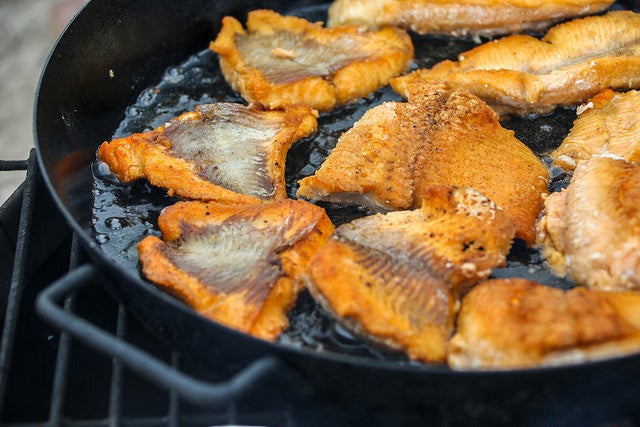
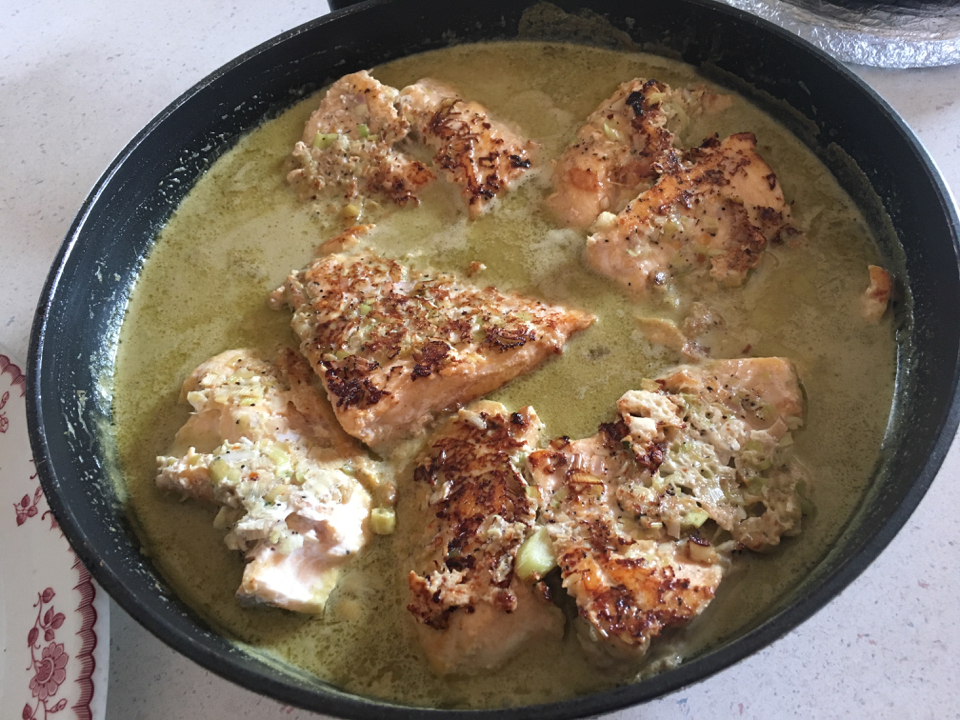
Contact us to learn more about our amazing trips
Canada’s Wild Arctic – Northwest Territories Barrenlands
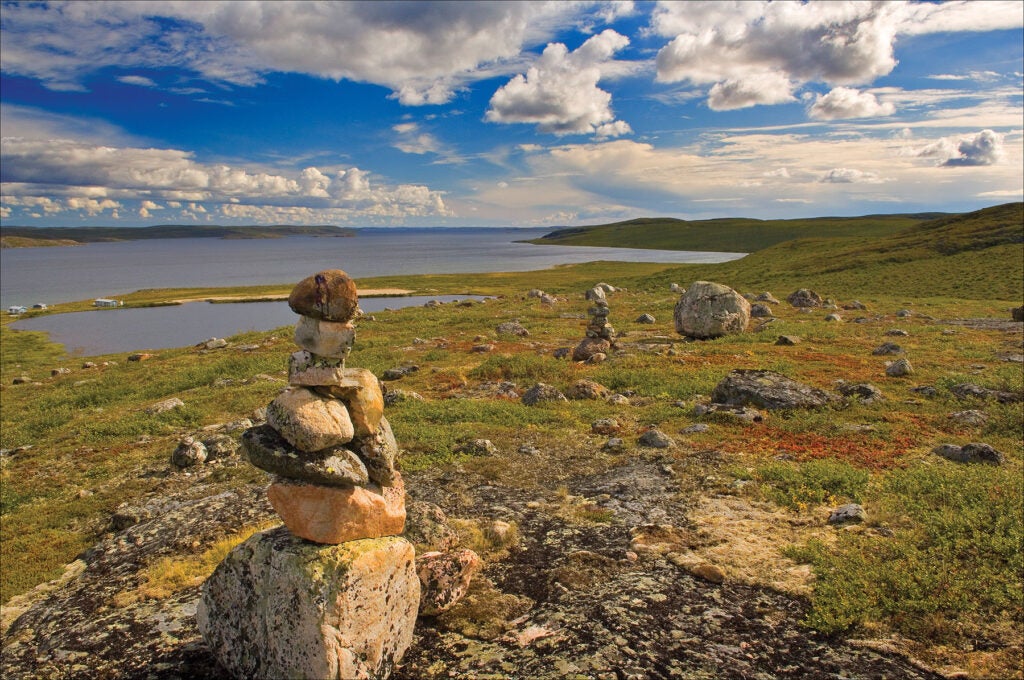
It’s no wonder that you might feel like you’re walking on a land before time while you’re in the barrenlands. This is where time is told in earths history, rocks near Peterson’s Point Lake Lodge have been dated over 3.2 billion years old and, not too far away, is the Acasta Gneiss where the world’s oldest rock was dated around 4 billion years old.
The barren lands is defined as a large area of tundra. It’s an amazing feature in and of itself and supports a unique ecosystem. Three seasons, spring, summer and fall (autumn), are condensed, and after the nine months of winter this land bursts with life. As the snow thaws and ice melts, it reveal lakes filled with a bounty of fish, providing the best trophy lake trout fishing experiences. The ground reveals a landscape covered with dwarf shrubs, grasses, lichens, mosses and minutes plants, it’s a naturalist paradise. It’s also home to a variety of wildlife, birds, insects, some migrate through the area, others inhabit the area seasonally and few stay over the winter.
Innumerable bodies of water and legendary rivers, such as the Coppermine River flow throughout the region. Back in 1821 during Sir John Franklin’s first overland trip to the Arctic Coast, he used the Coppermine River in search for the Northwest Passage as did earlier aboriginal peoples. Look closely when you visit as you may just find pieces of human history that date back hundreds of years.
Peterson’s Point Lake Lodge (PPLL) is located along the Coppermine River System, it’s nestled on the south-west end of Point Lake, where the taiga shield meets the barrens (southern arctic ecozone). Stunted forests grow in sheltered areas and valleys until they merge with the rolling hills created from glacial retreat.
As the midnight sun begins to subside, the landscape changes from the summer greens to reds, yellows, and oranges. The vibrant colours are breath-taking and offer incredible hiking and photo opportunities such as Peterson’s Point Lake Lodge Arctic Photography Workshop. Just imagine walking in a landscape of radiant crimson.
Wildlife – Caribou, Grizzly Bears, Wolves, Moose, Wolverine & More
Every summer barren-ground caribou migrate from the calving ground near the Arctic Coast towards the treeline. Peterson’s Point Lake Lodge lies in the midst of their migration route. Travelling along time honoured trails caribou pass though the Point Lake area each season. You can see their trails carved into the landscape. Wolves inhabit the area and den in nearby sand eskers, following their primary food source, caribou. Grizzly bears, moose and the elusive wolverine can be seen on the rolling terrain near the shore of Point Lake or foraging in the valleys where stunted trees and dwarf willow grow.
Smaller mammals like the Sic Sic, Arctic Hare, Red Fox, Otter and Weasel can also been seen by those with sharp eyes and migratory birds like falcons, hawks, eagles, swans, loons, ptarmigan, sparrows and warblers are commonly sighted around the lodge. It’s a true barrenland arctic photo safari and nature lovers dream.
Tour the barrens with our amazing trips: Summer Fishing, Autumn Hiking, Fall Photography and Autumn Aurora
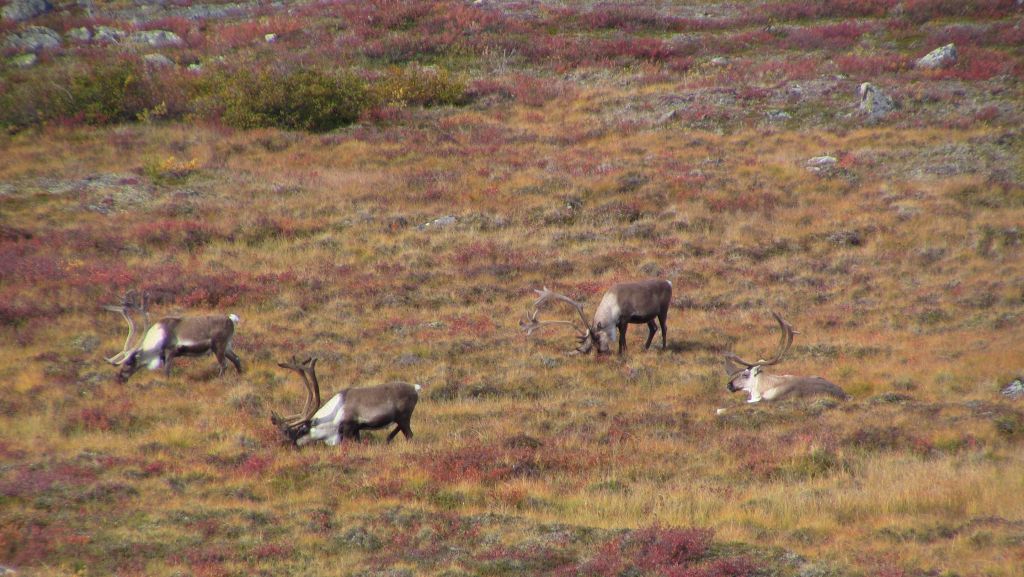
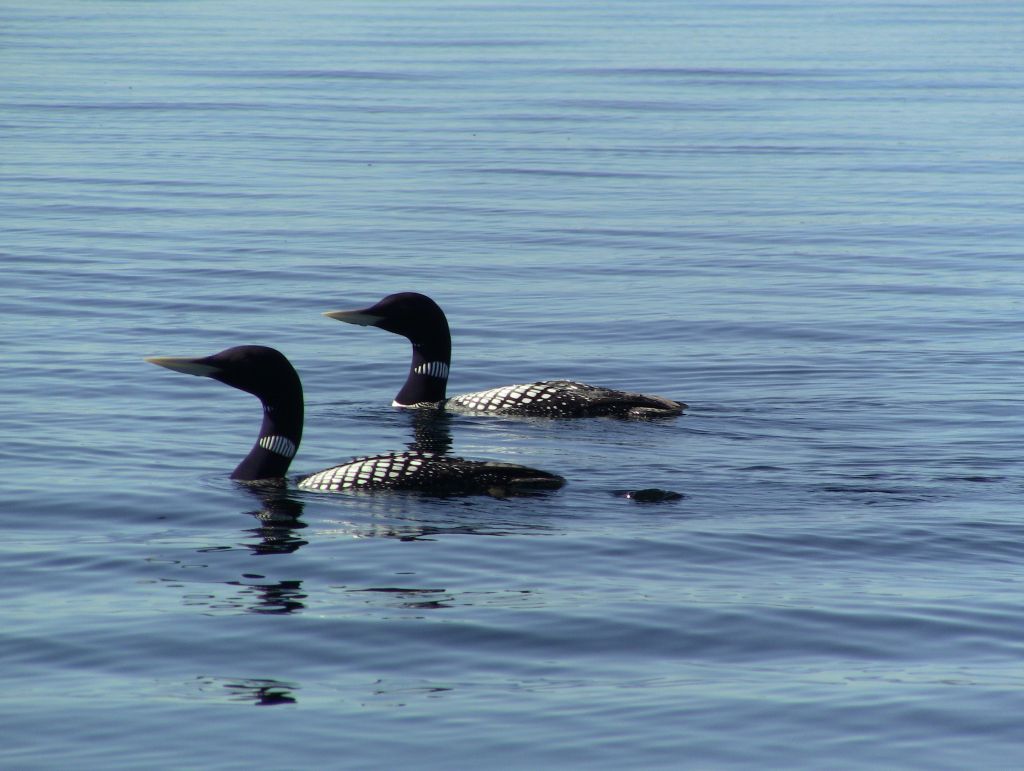
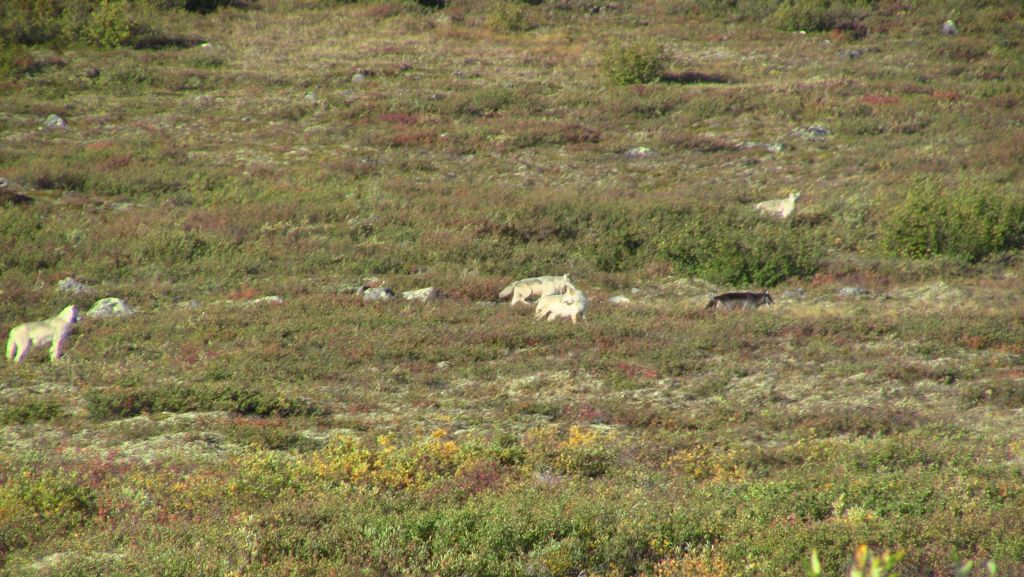
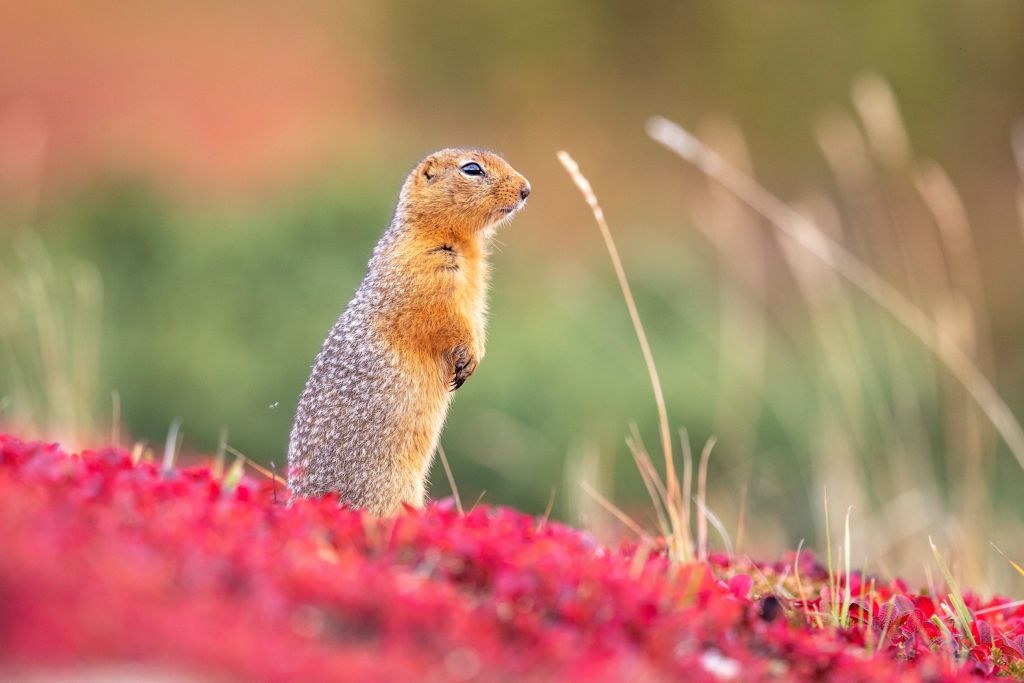
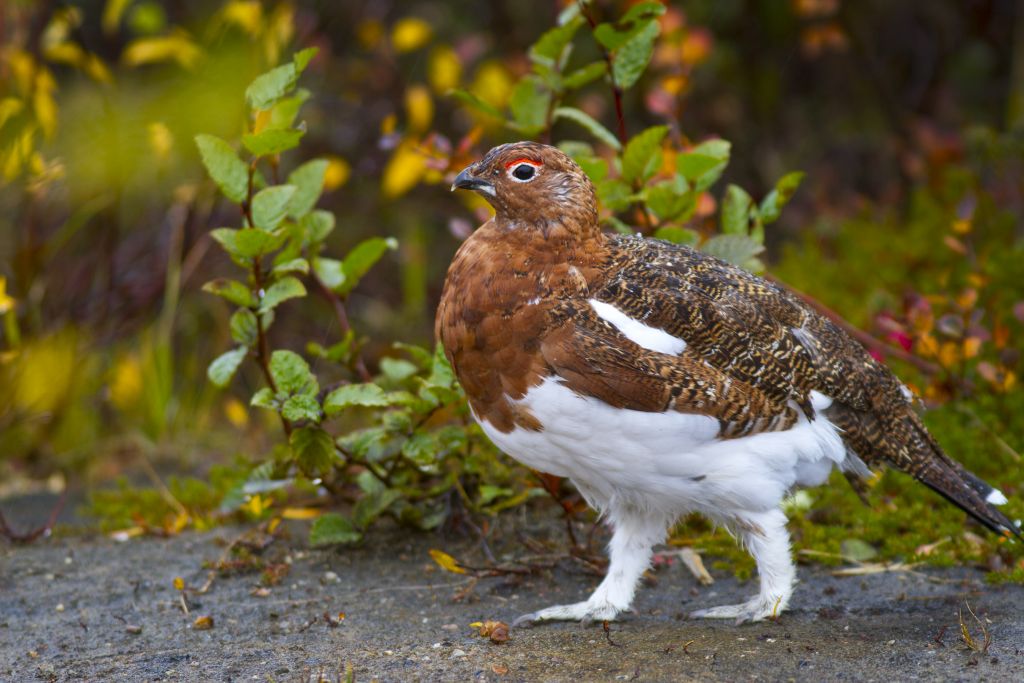
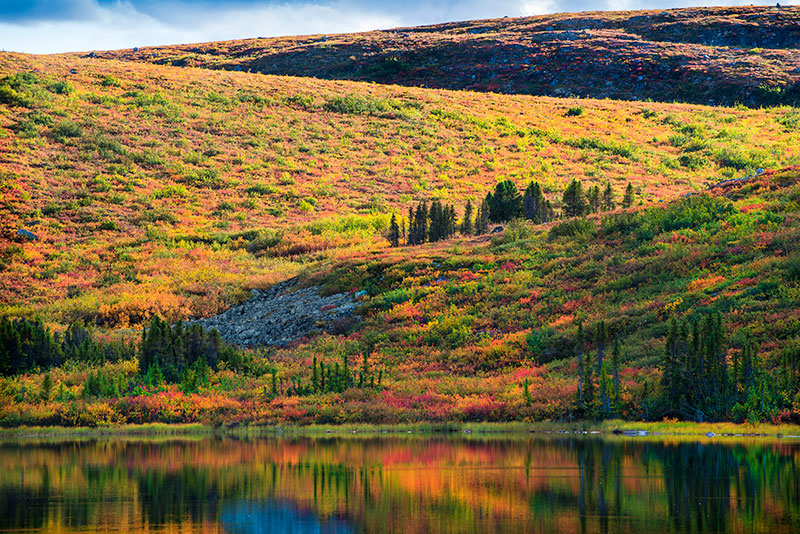
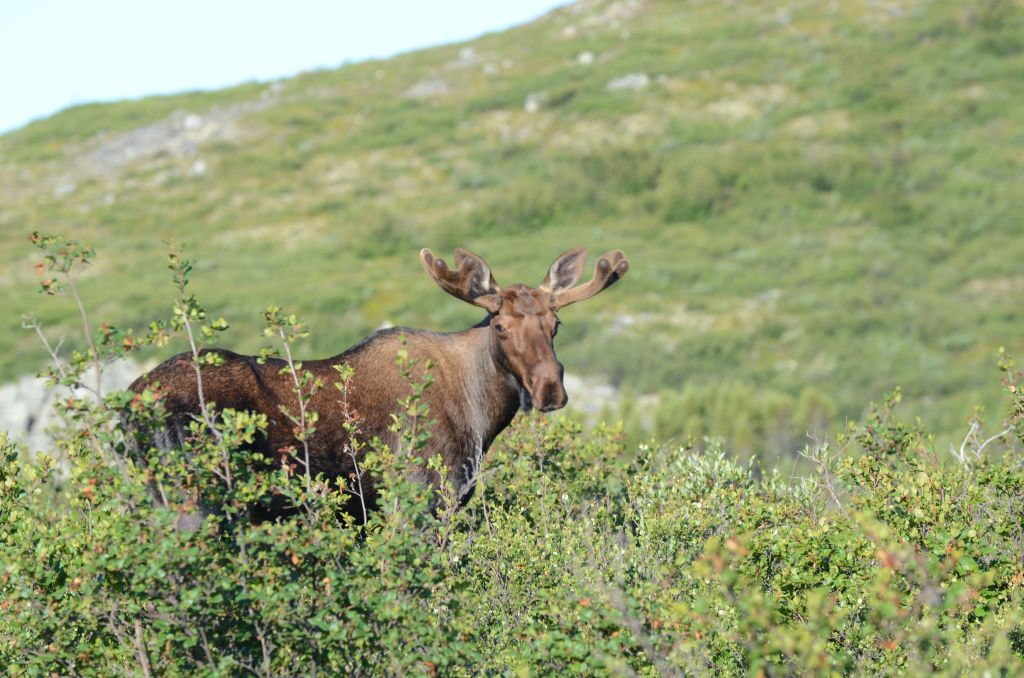
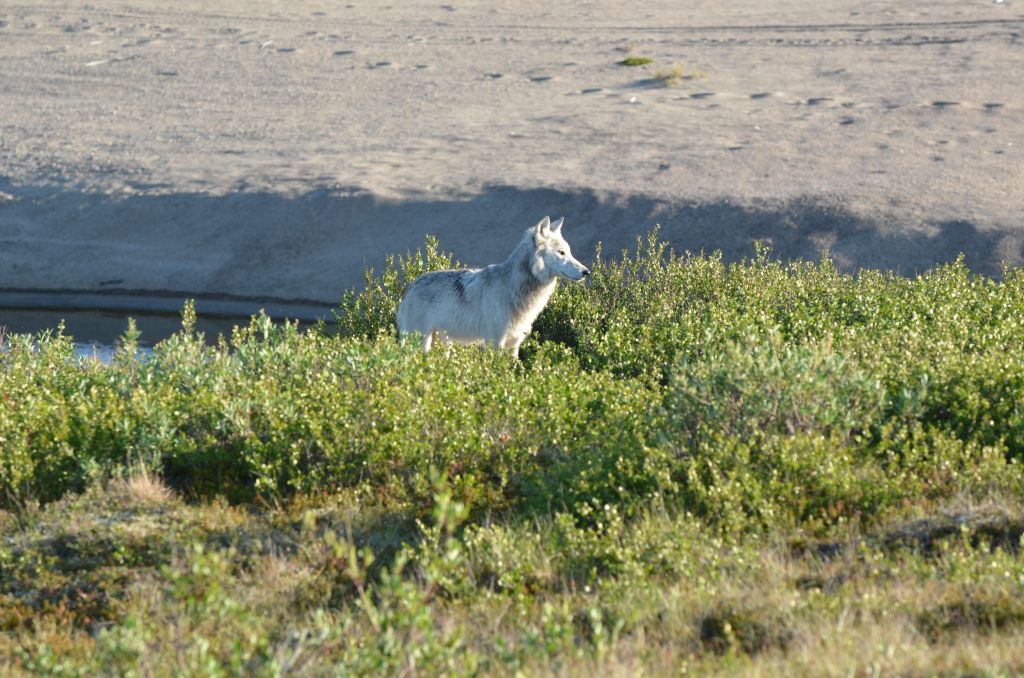
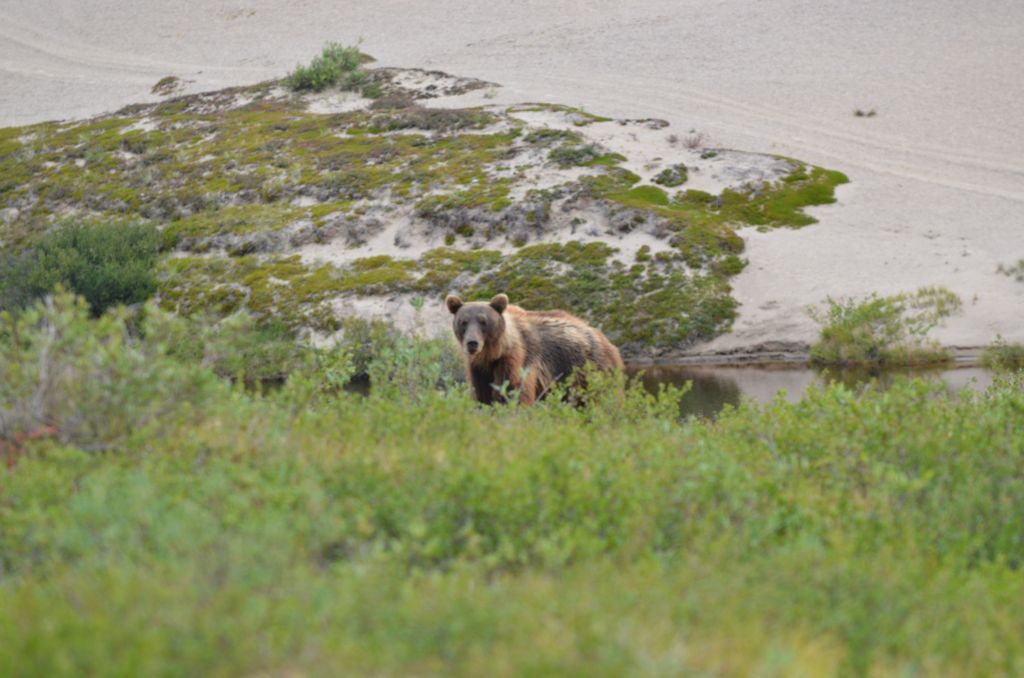
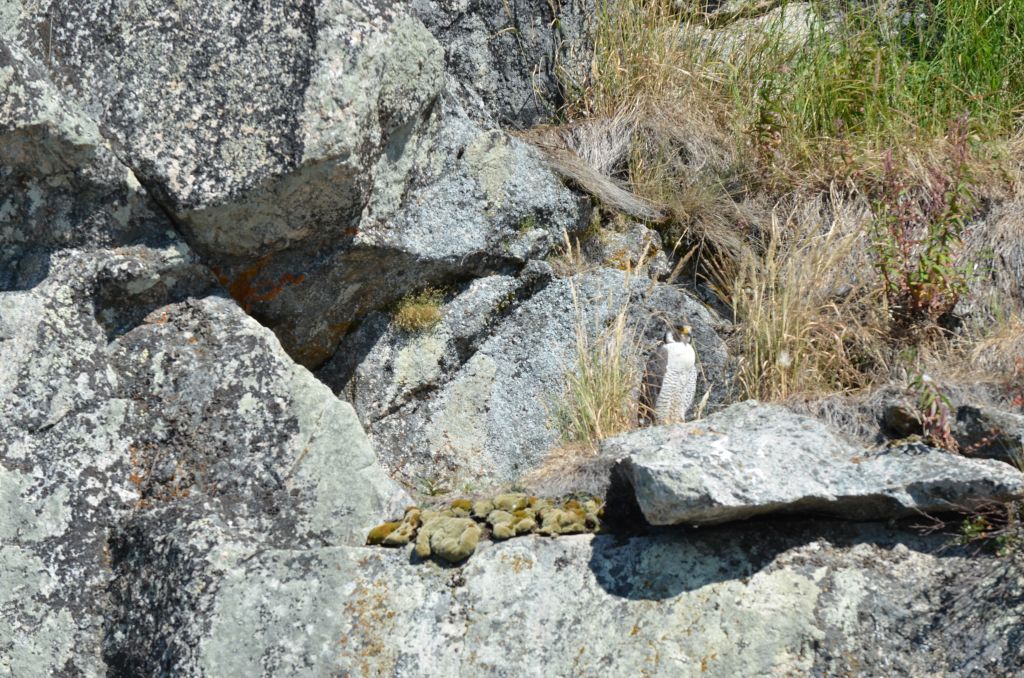
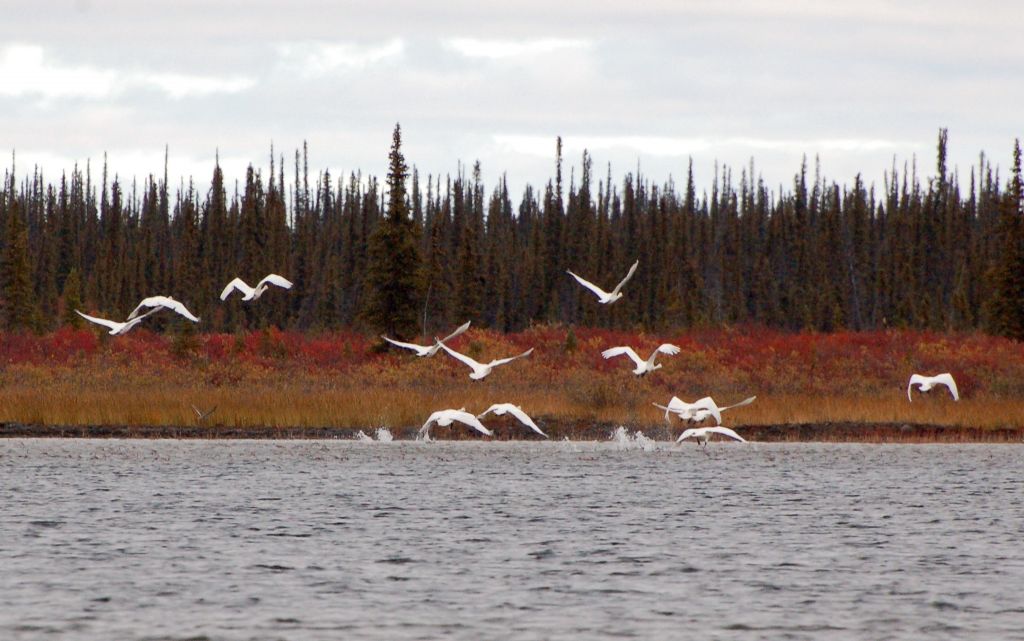
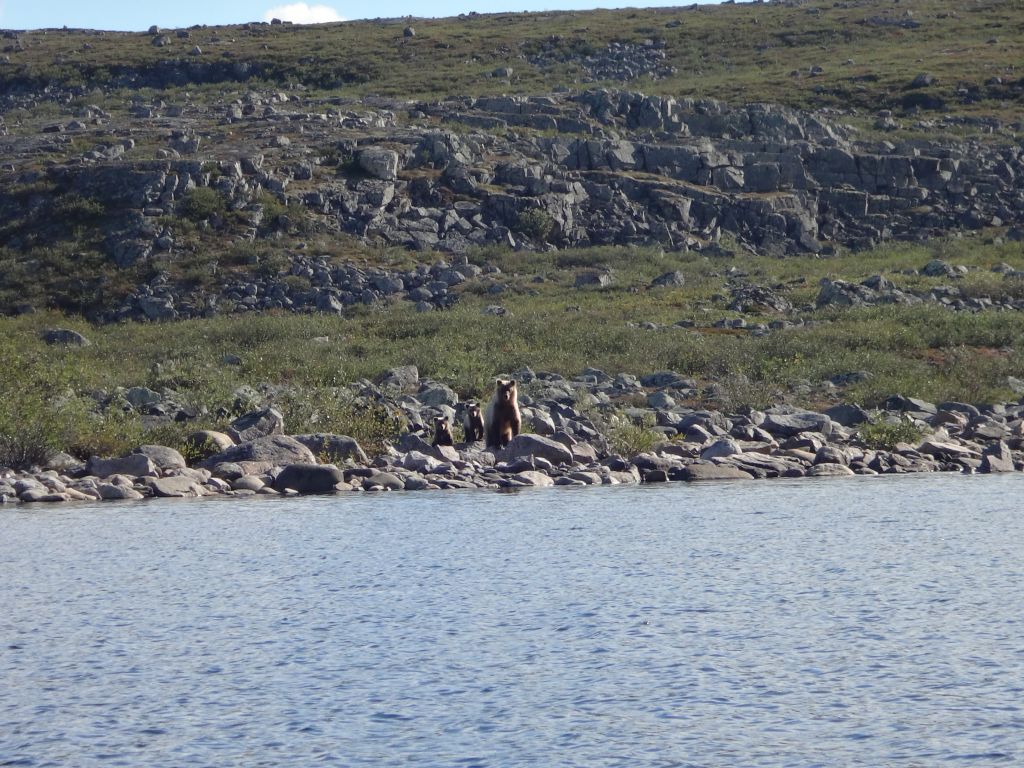
The Northern Lights – Aurora Borealis
Beyond the beauty of the land, the night sky is awe-inspiring. On those clear dark sky nights, the aurora can be seen in ever changing displays from arcs, bands, rays, pillars (curtains), diffuse and coronas. The backdrop to natures light show, is a dark, starlit sky, that stretches unrestricted from one horizon to the next. It’s magical to see the northern lights, which can easily be viewed with the naked eye. However, with a little help from a camera, you should be able to capture the different shapes and colours which range from white, greens, pinks, purples and reds.
The relatively dry (semi arid) climate, enhances the night sky viewing, as does the sweeping landscapes, and a lake right outside your cabin for reflections; the sheer number of stars and milky way photography will just add to your night time shooting experiences.
Take advantage of this remote, uncrowded and beautiful location to experiment with light painting, star-trails, time-lapse or just sit back and enjoy the show. Read more about why we think our aurora lodge is the best place to see northern lights here.
There are only three dates available to view the northern lights, during the Arctic Photography Workshop (2 dates only) or Aurora Experience (1 date only). These trips are scheduled to correspond peak of the autumn colors, wildlife and aurora viewing opportunities.
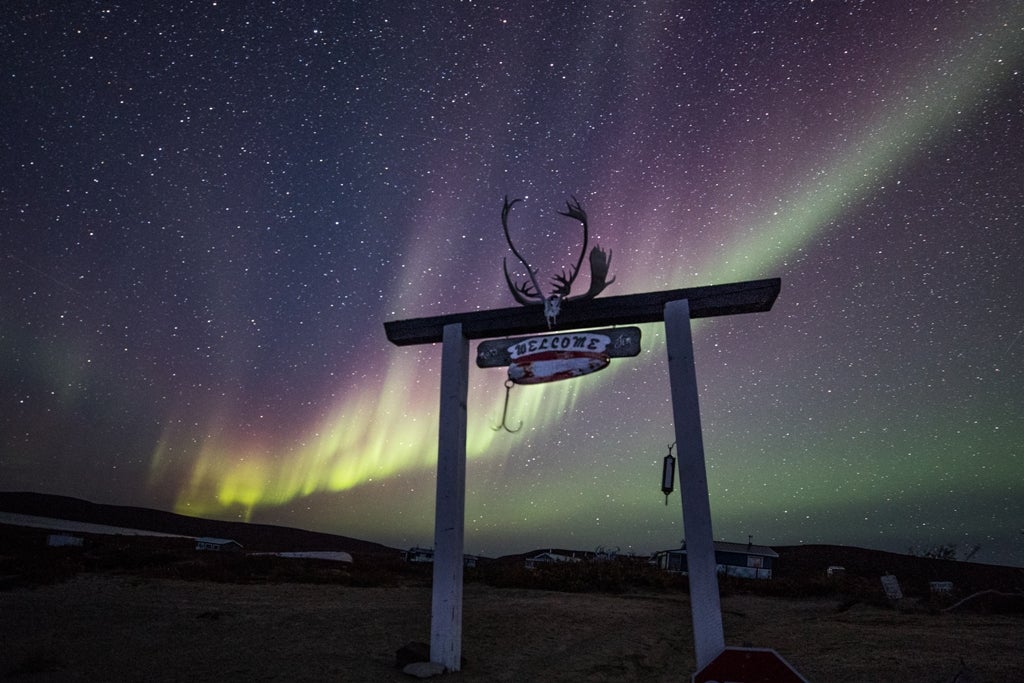
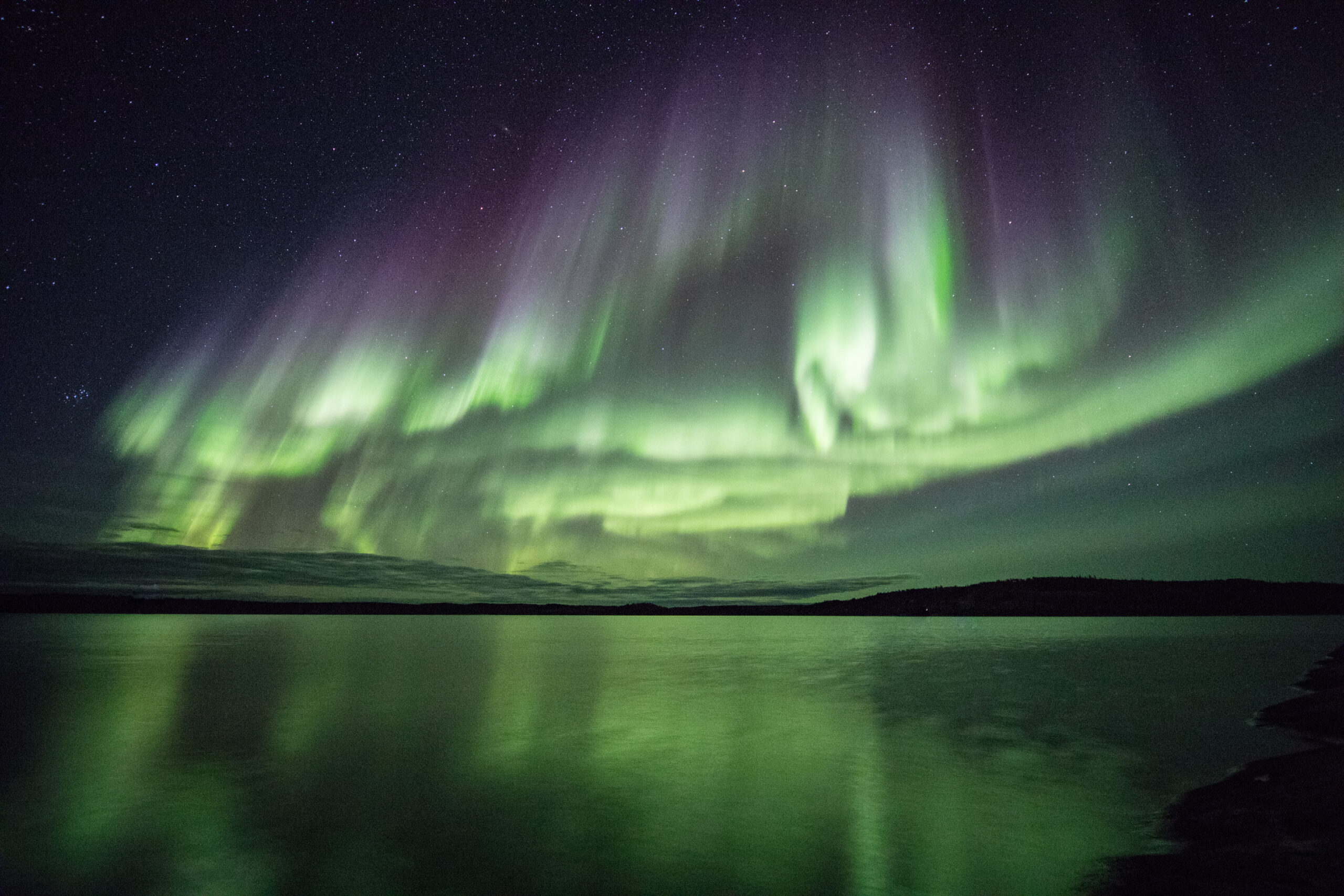
For more information about our extraordinary trips contact us
Updated June 7, 2024
